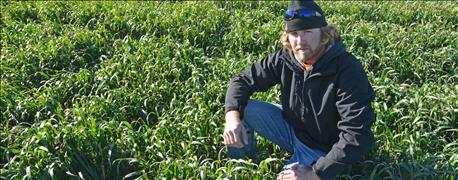October 17, 2016

Keeping it simple works for a lot of things on the farm. Tony Wagner applies that principle to cover crops.
If a wheat field is going to be planted to corn the following year, he plants barley as a cover crop because he can spray any barley plants that come back in the spring with Roundup and kill them.
If the field is going to be planted to wheat, he’ll plant oats as a cover crop because he can use a wild oat herbicide to control any oats that germinate in the spring.

STILL GREEN: Tony Wagner checks a cover crop that was still green in November last year.
If the field is going to be planted to soybeans, he plants cereal rye because he wants the cover crop to be green and growing in the spring, and the allopathic effect of the rye helps reduce the weed population or keeps the weeds small, which makes them easier to control.
Sometimes he’ll mix field pea and radish seed in with the barley, oats or rye to increase the diversity of the cover crop. Diversity improves soil health.
Wagner, Jamestown, N.D., has been using cover crops since 2012 and is now planting cover crops after all of his and his father’s small grain, soybean and field pea crops. He says Lee Briese, a Centrol agronomist, and Abbey Wick, North Dakota State University Extension soil health specialist, have been helping him explore practices.
Three other things Wagner does to keep cover cropping simple:
• Raises his own seed. If you have to buy seed, planting cover crops — especially mixtures of different species — can get costly, he says. By planting saved barley, oats and rye seed, Wagner says he gets by for $5 to $7 per acre, which is “pretty darn cheap” for the soil health, erosion control, weed suppression and forage soil health benefits the cover crops provide.
• Stores cover crop seed in 1,000-bushel hopper bins. He bought the old bins that weren’t being used “for almost nothing,” he says. “They’re not pretty to look at, but they are dry.”
• Has his air seeder ready to go when harvest begins. He wants to be prepared to seed a cover crop as soon as the field is combined. “You can’t wait to finish up harvesting and then line up seed and get your seeder ready,” Wagner says. He usually plants the cover crop in the morning while waiting for the dew on the wheat, soybeans or field peas to evaporate.
Selecting a field to try a cover crop on doesn’t have to be complicated.
“If you have a slough, I’d start there,” Wagner advises.
Seeding barley, oat or cereal rye around a slough keeps the soil salts from expanding into the field. Square off the area or just make a couple rounds around it with an air seeder, he says.
Another good place to try a cover crop is on a field that will blow after a low-residue crop such as dry beans, soybeans or field peas is harvested. If a cover crop gets established, you’ll reduce erosion. That will be a win in itself. Any other benefits that the cover crops provide will be a bonus.
You May Also Like




